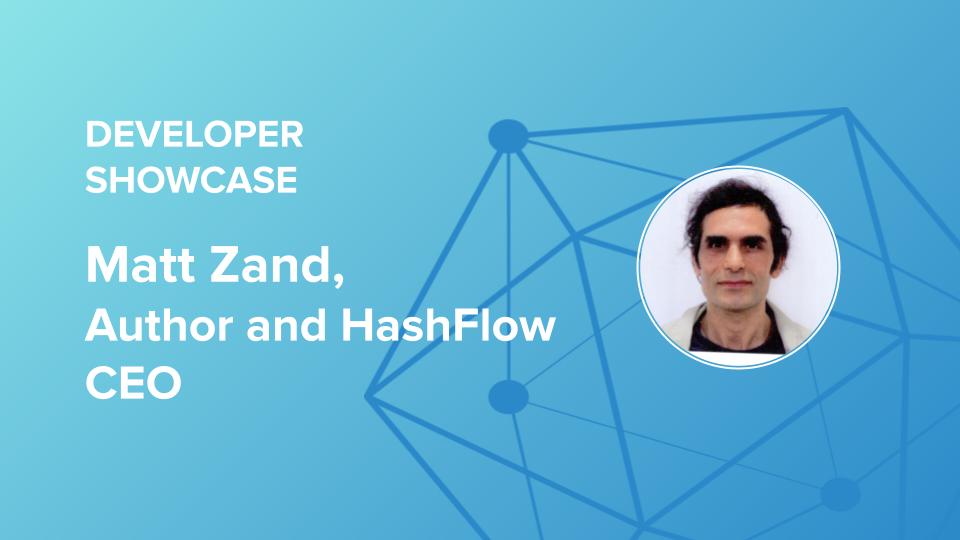Developer showcase series: Matt Zand, author and HashFlow CEO

Back to our Developer Showcase Series to learn what developers in the real world are doing with Hyperledger technologies. Next up is Matt Zand, CEO of HashFlow and co-author of Hands-On Smart Contract Development with Hyperledger Fabric V2 by O’Reilly Media.
(Editor’s note: As of March 1, 2023, Matt Zand became CEO of Zuma Dating. This note was posted on April 26, 2023, to reflect that update.)
Give a bit of background on what you’re working on, and let us know what was it that made you want to get into blockchain?
I started an IT company in Maryland in 2010. Since then I gradually moved from custom web development to mobile app development services. In 2019, I started exploring blockchain technology and mastered all of its concepts and platforms. In 2020, I decided to write a book on Hyperledger Fabric V2, which came out last week. Beside my book, I have designed several blockchain course curricula and course materials for companies like O’Reilly Media as well as done several blockchain projects for our clients at HashFlow. Lastly, I have done several public speaking sessions in the Hyperledger community in North America and Europe.
What project in Hyperledger are you working on? Any new developments to share? Can you sum up your experience with Hyperledger?
NFT for financial products with Hyperledger Fabric, asset tokenization for digital banks with Hyperledger Fabric and Ethereum, B2B NFT in music industry, a SaaS product for customer loyalty management, healthcare payment system, an ICO product and an internet-connectivity reward system for the telecom industry just to name a few. In addition, my book covers several projects done on Hyperledger Fabric.
What advice would you offer other technologists or developers interested in getting started working on blockchain?
My advice is to start exploring blockchain concepts and its use cases. Then, try to map a blockchain solution to an existing business problem. In this step, you learn how to design a blockchain system as a solution architect. Finally, pick a platform (e.g., Hyperledger Fabric or Ethereum) and build a demo of your product. After you finish and launch your first blockchain application, you would be able to gradually dig deeper into more advanced blockchain implementations.
What are the main differences between developing blockchain applications in Hyperledger or Ethereum?
While working as CEO at HashFlow, I advise and architect different blockchain solutions based on client requirements and other considerations such as choice of cloud provider, performance, availability, and interoperability. Thus, the choice of platform comes after we design the project architecture. As a rule of thumb, private enterprise performance-sensitive applications are being built with Hyperledger Fabric, whereas public applications like utility tokens are best suited with Ethereum.
What do you think is most important for Hyperledger to focus on in the next year?
The most important thing Hyperledger can focus on is increasing the number of transactions per second. It would also be great to have Hyperledger tools and libraries that are currently at incubation stage become active.
As Hyperledger’s incubated projects start maturing and hit 1.0s and beyond, what are the most interesting technologies, apps, or use cases coming out as a result from your perspective?
Hyperledger Transact is a really interesting product. We need methods for quickly creating distributed ledger technology (DLT) applications.
What’s the one issue or problem you hope blockchain can solve?
Blockchain is going to solve many problems. However, I am looking forward to seeing more enterprise blockchain projects moving forward from the PoC stage to production.
Where do you hope to see Hyperledger and/or blockchain in five years?
I hope to see a robust and prevalent acceptance of Hyperledger DLTs among enterprise projects. Also, I like to see more collaboration on projects like Hyperledger Besu where public and private blockchain developers would be able to collaborate.
What is the best piece of developer advice you’ve ever received?
Spend more time on architecting a solution thoroughly than developing it.
What technology could you not live without?
The Internet.
Sign up for Hyperledger Horizon & /dev/weekly newsletters
By signing up, you acknowledge that your information is subject to The Linux Foundation's Privacy Policy